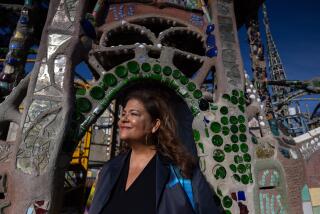‘St. John the Unfinished’ : Stonemasons Represent Activism, Tradition
- Share via
NEW YORK — Ruben Gibson chisels a medieval saint in limestone with a clear staccato ring, beating an unlikely refrain above his Harlem neighborhood.
Gibson also carves gargoyles and other figures for the Cathedral of St. John the Divine, bringing Gothic art from 12th-Century Europe to this area, which includes Columbia University on one side, Morningside Park on the other, and overlooks Harlem and the rest of upper Manhattan.
Along with 14 other stonemasons from depressed New York City communities, he is part of renewed construction after a 38-year hiatus on the world’s largest Gothic cathedral, dubbed by New Yorkers “St. John the Unfinished.”
For seven years Gibson has made a living sculpturing birds, beasts, and vines into some of the 24,000 stones for the cathedral’s two west towers as part of a $30 million building project.
The stonemasons are transforming what the Right Rev. Paul Moore Jr. calls a “screaming anachronism”--the cathedral--into a “weave of social conscience with the historical, religious, and architectural aspects of Christianity.”
Ideal Blend
The stonemasons’ training and industry exemplify the ideal of merging social activism with Christian tradition, says Bishop Moore, the bishop of the Episcopal Diocese of New York.
The cathedral, which already sponsors concerts, art exhibits, and resident artists like high-wire acrobat Philippe Petit, has sought to emulate a cathedral’s traditional role in medieval Europe as the center of local culture and folk arts.
Church officials say the stonemasons, who come from local neighborhoods that annually benefit from some $1 million worth of cathedral-sponsored social programs, are giving something lasting to the community.
Alan Bird, the British-born foreman of the project, recalls earlier workers “who died this century and last century dreaming that the cathedral would be complete.” His aim is to ensure that the stonemasons continue that tradition of artisanry.
From 1892 until 1911, stonemasons constructed a Romanesque crossing and high altar for the Harlem Heights cathedral. The death of the architect prompted a five-year hiatus and a switch to the Gothic style for the nave. Church leaders halted construction again in 1941 with the outbreak of World War II, and the cathedral sat neglected on its bluff overlooking Harlem until 1979.
With the high altar 601 feet from the rose window--nearly 200 feet farther than the distance from home plate to the center field wall at Yankee Stadium--most services are conducted in the crossing around a portable altar closer to the congregation. Above this altar, the ceiling rises high enough to fit the 152-foot-tall Statue of Liberty under its central Romanesque dome.
Although Bird says the unfinished cathedral is “too perpendicular and too well-proportioned and shaped” to match the irregular, “man-made” beauty of its European counterparts, master stone carver Nicholas Fairplay adds that the “cathedral has energy because it’s unfinished.”
“It looks like a huge, growing organism,” said Fairplay, one of three Britons guiding the project. Cut and carved by local hands in three phases over nearly a century, the cathedral has avoided the “wedding cake” appearance of the National Cathedral in Washington, scheduled for completion in 1989 after 82 years of construction, he says.
While the first builders of the cathedral shaped stone assembly-line fashion, the British artisans have encouraged their American apprentices to work with one block until its completion. In the carving shed, five sculptors consult photographs of European cathedrals, perhaps studying a dancing peasant woman at Cologne or a snarling lion at Chartres.
Staying in Style
Then they critique one another’s carving “to make sure we stay with the Gothic style,” says Gibson, the senior journeyman stone carver. Chiseling in the Gothic motif, they create a wide variety of beasts, human figures, and plants.
The stonecutters, working in the large metal warehouse known as the cutting room, avoid the use of modern-day pneumatic drills and sanders. Instead, they shape the stone the way medieval workers did, by hand, using chisels, with each worker leaving his own distinctive fretting, called “boasting,” on the stone.
Bird agrees that the cathedral has helped many of the workers earn a steady living in the midst of harsh ghetto life. But he says observers often “make a big deal about the theatrics of the church employing young people from this area who otherwise would be out of work.”
“They’re professionals, and there’s no point getting so excited about their past,” says Bird, who also was the master stonecutter and foreman of a project to renew Wells Cathedral in Somerset, England.
“You don’t want a cathedral to represent the kind of conveyor-type of world people go to church to get away from,” Bird says.
The journeymen stonemasons may leave a personal mark on the stone, but, like the workers before them, they probably will not see the cathedral completed. They plan to finish the south tower by St. John’s Day, Dec. 27, 1992, 100 years after the ground breaking, and to put the last stone to the royal gallery and north tower in 1998.
But with the much larger north and south transepts and central tower still just part of the gift-shop model, the work will go on well into the next century. Bird aims to start recruiting the children of the workers, particularly the 9-year-old son of Jose Tapia, the senior journeyman stonecutter.
Surrounded by stonemasons chipping away at rock in a quick, high melody, Tapia, a 27-year-old resident of Spanish Harlem, says of his son: “I hope he picks it up--I pray to God he picks it up.”
More to Read
The biggest entertainment stories
Get our big stories about Hollywood, film, television, music, arts, culture and more right in your inbox as soon as they publish.
You may occasionally receive promotional content from the Los Angeles Times.










